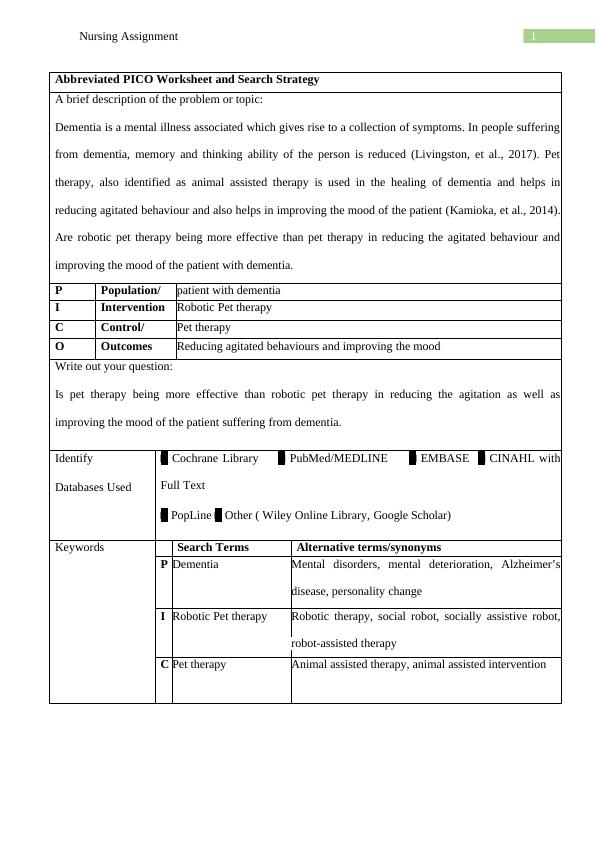Comparing Robotic Pet Therapy and Pet Therapy for Dementia Patients
Added on 2023-04-07
7 Pages1512 Words123 Views
Running head: NURSING ASSIGNMENT
Nursing assignment
Name of the student:
Name of the university:
Author’s note:
Nursing assignment
Name of the student:
Name of the university:
Author’s note:

1Nursing Assignment
Abbreviated PICO Worksheet and Search Strategy
A brief description of the problem or topic:
Dementia is a mental illness associated which gives rise to a collection of symptoms. In people suffering
from dementia, memory and thinking ability of the person is reduced (Livingston, et al., 2017). Pet
therapy, also identified as animal assisted therapy is used in the healing of dementia and helps in
reducing agitated behaviour and also helps in improving the mood of the patient (Kamioka, et al., 2014).
Are robotic pet therapy being more effective than pet therapy in reducing the agitated behaviour and
improving the mood of the patient with dementia.
P Population/
Patient/
patient with dementia
I Intervention Robotic Pet therapy
C Control/
Comparison
Pet therapy
O Outcomes Reducing agitated behaviours and improving the mood
Write out your question:
Is pet therapy being more effective than robotic pet therapy in reducing the agitation as well as
improving the mood of the patient suffering from dementia.
Identify
Databases Used
□ Cochrane Library □ PubMed/MEDLINE □ EMBASE □ CINAHL with
Full Text
□ PopLine □ Other ( Wiley Online Library, Google Scholar)
Keywords Search Terms Alternative terms/synonyms
P Dementia Mental disorders, mental deterioration, Alzheimer’s
disease, personality change
I Robotic Pet therapy Robotic therapy, social robot, socially assistive robot,
robot-assisted therapy
C Pet therapy Animal assisted therapy, animal assisted intervention
Abbreviated PICO Worksheet and Search Strategy
A brief description of the problem or topic:
Dementia is a mental illness associated which gives rise to a collection of symptoms. In people suffering
from dementia, memory and thinking ability of the person is reduced (Livingston, et al., 2017). Pet
therapy, also identified as animal assisted therapy is used in the healing of dementia and helps in
reducing agitated behaviour and also helps in improving the mood of the patient (Kamioka, et al., 2014).
Are robotic pet therapy being more effective than pet therapy in reducing the agitated behaviour and
improving the mood of the patient with dementia.
P Population/
Patient/
patient with dementia
I Intervention Robotic Pet therapy
C Control/
Comparison
Pet therapy
O Outcomes Reducing agitated behaviours and improving the mood
Write out your question:
Is pet therapy being more effective than robotic pet therapy in reducing the agitation as well as
improving the mood of the patient suffering from dementia.
Identify
Databases Used
□ Cochrane Library □ PubMed/MEDLINE □ EMBASE □ CINAHL with
Full Text
□ PopLine □ Other ( Wiley Online Library, Google Scholar)
Keywords Search Terms Alternative terms/synonyms
P Dementia Mental disorders, mental deterioration, Alzheimer’s
disease, personality change
I Robotic Pet therapy Robotic therapy, social robot, socially assistive robot,
robot-assisted therapy
C Pet therapy Animal assisted therapy, animal assisted intervention

2Nursing Assignment
O Reducing agitated
behaviour and
improving the mood
Temper balancing, reducing nervousness, balancing
frame of mind, anxiety, promoting quality life
Search filters or
limit
□Age □ Language (English) □ Publication years (2014-2017) □
Other (peer reviewed)
Citation: Moyle, W., Jones, C. J., Murfield, J. E., Thalib, L., Beattie, E. R., Shum, D. K., ...
& Draper, B. M. (2017). Use of a robotic seal as a therapeutic tool to improve dementia
symptoms: A cluster-randomized controlled trial. Journal of the American Medical Directors
Association, 18(9), 766-773.
Annotation:
The authors of the article are doctorates holders and professors of Griffith University in
Australia. The determination of this report is to gauge the efficacy of socially assistive robots
in reducing aggression and anxiety in patient with dementia over animal assisted therapy. In
the article respondents were treated with treated in three groups, one with plush toy, second
with robotic pet and third with living animals. It is observed that the patient treated with
robotic seal has shown speedy recovery as compared to other animals. I believe that the study
is Nobel and the information provided are also true. It is under the five years’ frame work and
was listed under the Australian National Health and Medical Research Council.
Credible
Citation: Petersen, S., Houston, S., Qin, H., Tague, C., & Studley, J. (2017). The utilization
of robotic pets in dementia care. Journal of Alzheimer's Disease, 55(2), 569-574.
Annotation:
The author of this research are professor, director and doctors of College of Nursing & Health
Sciences in USA. The aim of this research is to identify the effectiveness of robotic pet
O Reducing agitated
behaviour and
improving the mood
Temper balancing, reducing nervousness, balancing
frame of mind, anxiety, promoting quality life
Search filters or
limit
□Age □ Language (English) □ Publication years (2014-2017) □
Other (peer reviewed)
Citation: Moyle, W., Jones, C. J., Murfield, J. E., Thalib, L., Beattie, E. R., Shum, D. K., ...
& Draper, B. M. (2017). Use of a robotic seal as a therapeutic tool to improve dementia
symptoms: A cluster-randomized controlled trial. Journal of the American Medical Directors
Association, 18(9), 766-773.
Annotation:
The authors of the article are doctorates holders and professors of Griffith University in
Australia. The determination of this report is to gauge the efficacy of socially assistive robots
in reducing aggression and anxiety in patient with dementia over animal assisted therapy. In
the article respondents were treated with treated in three groups, one with plush toy, second
with robotic pet and third with living animals. It is observed that the patient treated with
robotic seal has shown speedy recovery as compared to other animals. I believe that the study
is Nobel and the information provided are also true. It is under the five years’ frame work and
was listed under the Australian National Health and Medical Research Council.
Credible
Citation: Petersen, S., Houston, S., Qin, H., Tague, C., & Studley, J. (2017). The utilization
of robotic pets in dementia care. Journal of Alzheimer's Disease, 55(2), 569-574.
Annotation:
The author of this research are professor, director and doctors of College of Nursing & Health
Sciences in USA. The aim of this research is to identify the effectiveness of robotic pet

End of preview
Want to access all the pages? Upload your documents or become a member.
Related Documents
Benefits of Pet Therapy and PARO Robot in Healthcarelg...
|7
|1701
|5
Evidence and Recommendations for Pet Therapy and PARO Robot in Dementia Carelg...
|5
|1683
|43
The Benefit of Pets and Animal-Assisted Therapy to the Health of Older Individuals PDFlg...
|13
|4288
|247
